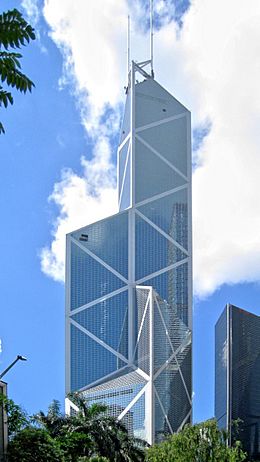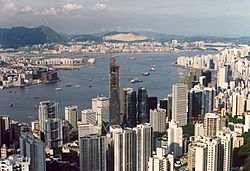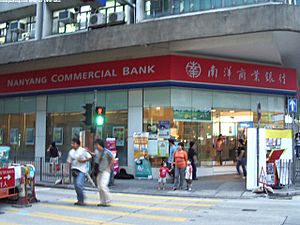Bank of China (Hong Kong) facts for kids
 |
|

Bank of China Tower in Hong Kong
|
|
|
Native name
|
中國銀行(香港)有限公司
|
|---|---|
| Public | |
| Traded as |
|
| Industry | Financial services |
| Founded |
|
| Headquarters | Bank of China Tower, Central, |
|
Key people
|
Ge Haijiao, Chairman Sun Yu, Vice chairman and Chief Executive |
| Products |
|
|
Operating income
|
|
| Total assets | |
|
Number of employees
|
|
| Parent | Bank of China |
| Subsidiaries | Bank of China (Thai) Bank of China (Malaysia) |
| Bank of China (Hong Kong) Limited | |||||||||||||
|---|---|---|---|---|---|---|---|---|---|---|---|---|---|
| Traditional Chinese | 中國銀行(香港)有限公司 | ||||||||||||
| Simplified Chinese | 中国银行(香港)有限公司 | ||||||||||||
| Jyutping | zung1 gwok3 ngan4 hong4 (hoeng1 gong2) jau5 haan6 gung1 si1 | ||||||||||||
|
|||||||||||||
| Alternative Chinese name | |||||||||||||
| Traditional Chinese | 中銀香港 | ||||||||||||
| Simplified Chinese | 中银香港 | ||||||||||||
| Jyutping | zung1 ngan4 hoeng1 gong2 | ||||||||||||
|
|||||||||||||
Bank of China (Hong Kong) Limited, often called BOCHK, is a big bank in Hong Kong. It is part of the Bank of China group. BOCHK is one of the largest banks in Hong Kong. It has many branches and helps people and businesses with their money.
BOCHK is special because it is one of only three banks in Hong Kong that can print Hong Kong dollar banknotes. It also helps manage the Chinese currency, the Renminbi, in Hong Kong. This means it helps other banks handle money that comes from or goes to mainland China.
The bank was created on October 1, 2001. This happened when 12 smaller banks that belonged to the Bank of China group in Hong Kong joined together. A year later, in October 2002, BOCHK became a public company. Its main office is in the Bank of China Tower in Central, Hong Kong. This tall building is a famous landmark in Hong Kong.
Contents
How BOCHK Started
Early Chinese Banks in Hong Kong
The Bank of China first opened a branch in Hong Kong in 1917. This was the start of Chinese government-owned banks in Hong Kong. Other banks from mainland China soon followed. By 1949, there were 15 branches of state-owned Chinese banks in Hong Kong. There were also branches of nine other banks that were partly owned by the government and partly by private companies.
The Chinese government also started two new banks in Hong Kong: Po Sang Bank in 1949 and Nanyang Commercial Bank in 1950.
Joining Forces: The Bank of China Group
In 1952, nine of the public-private banks started working together. Later, in 1958, the Bank of China took over managing six of these banks. It also managed other banks like Kwangtung Provincial Bank.
By the 1980s, these 14 banks were known as the Bank of China Group. They started using the same computer systems and worked together more closely. Even though they had their own managers, they became a strong banking group in Hong Kong.
Becoming a Public Company
In 1999, the Bank of China Group began to change how it worked. This was to get ready to offer its shares to the public. In January 2001, plans were approved to combine many of these banks.
All the operations of the mainland-owned banks in Hong Kong were merged into Po Sang Bank. This bank was then renamed Bank of China (Hong Kong) Limited. Two other Hong Kong banks, Nanyang Commercial Bank and Chiyu Banking Corporation, became part of BOCHK. This big merger was completed on October 1, 2001. In July 2002, BOCHK's shares were listed on the Hong Kong Stock Exchange. This was the first time a major bank from mainland China was listed on an international stock exchange.
How BOCHK Works Today
BOCHK offers many financial services to people and businesses. These are similar to what most banks offer. They include taking deposits (money people put in the bank) and giving out loans (money people borrow). The bank also helps with personal loans, managing wealth, and other financial services.
BOCHK has a very large network in Hong Kong. As of late 2019, it had about 190 branches and over 1,000 ATMs. It is also one of the main banks that gives out home loans in Hong Kong.
Handling Chinese Currency (Renminbi)
Since February 2004, BOCHK has been the special bank for handling personal transactions with the Renminbi (RMB), which is the currency of mainland China, in Hong Kong. This means BOCHK helps other banks in Hong Kong exchange RMB banknotes and funds. It also acts as a link between Hong Kong banks and the People's Bank of China, which is China's central bank.
This arrangement was important because it was the first time the Renminbi could be easily used outside mainland China. It allowed Hong Kong banks to offer services like taking RMB deposits, exchanging RMB, and using RMB cards.
Nanyang Commercial Bank
Nanyang Commercial Bank started in Hong Kong in 1950. It is now fully owned by BOCHK and has 42 branches. This bank mainly helps businesses, especially smaller trading and manufacturing companies. It also has many customers from Chinese communities living outside China. In 2007, Nanyang Commercial Bank took over all of BOCHK's business operations in mainland China.
Chiyu Banking Corporation
Chiyu Banking Corporation Limited was founded in 1947. It has 23 branches in Hong Kong. This bank mainly serves people in Hong Kong who have family roots in Fujian province in China. The bank was created to use its profits to support education in Fujian. In 2017, BOCHK sold Chiyu Bank.
JETCO ATM Network
JETCO is the largest network of ATMs in Hong Kong and Macau. It has almost 3,000 cash machines. BOCHK helped start JETCO in 1982 with a few other banks. Today, almost all banks in Hong Kong and Macau use JETCO, except for HSBC and Hang Seng Bank, which have their own ATM system.
Other Services
BOCHK also owns a travel agency called BOC Travel Services. This agency helps customers with their travel plans.
BOCHK in Southeast Asia
Brunei
In 2016, BOCHK opened a branch in Brunei. It was the first Chinese bank to open a branch in that country.
Malaysia and Thailand
BOCHK also has branches in Malaysia and Thailand.
Hong Kong Banknotes
In Hong Kong, the money notes are not printed by a central bank like in most countries. Instead, three special commercial banks are allowed to print them. BOCHK is one of these three banks, along with HSBC and Standard Chartered Bank.
Bank of China started printing Hong Kong dollar notes on May 1, 1994. After the bank merged and changed its name in 2001, new notes with the name "Bank of China (Hong Kong)" started to be used in 2004. Even the old notes printed before the merger are still valid money.
As one of the banks that prints money, BOCHK also takes turns being the chairman of the Hong Kong Association of Banks. This is the main group for banks in Hong Kong.
The Bank of China Tower
The Bank of China Tower is a very tall building in Central, Hong Kong. It is where the main office of Bank of China Hong Kong is located. The building was designed by a famous architect named Ieoh Ming Pei.
The tower is 70 stories high and reaches 315 meters (about 1,033 feet). With its two masts, it goes up to 369 meters (about 1,211 feet). Construction started in 1985 and finished in 1989. It officially opened on May 17, 1990.
The Bank of China Tower was the first building outside North America to be taller than 1,000 feet. It was also the tallest building in Hong Kong and Asia from 1989 to 1992. There is a small viewing area on the 43rd floor that is open to the public.
The building's design looks like growing bamboo shoots. This is a symbol of life and good fortune. Its unique look makes it one of Hong Kong's most famous buildings today.
See also
- List of banks in Hong Kong
- Macanese pataca




